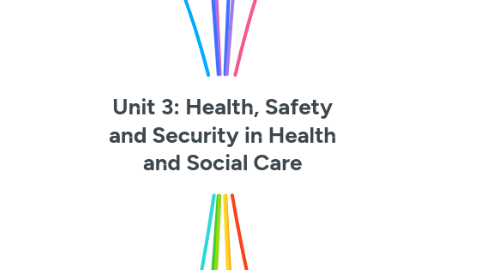
1. 1.2 Potential impact of hazards
1.1. Injury and Harm
1.2. Illness
1.3. Poor Standars of Care
1.4. Financial Loss
2. 2.2 Safeguarding
2.1. Protecting children from maltreament, preventing impairments of childrens health and development, ensuring children grow safe and effective care and taking actions for children had the best outcomes.
2.1.1. Disclosure and Barring Sevice (DBS) - Decisions and prevent unsuitable people working with vulnerable groups.
2.1.2. DBS Checks - Cerficate that contains details of spen and unspent convictions, cautions, reprimands and warnings that are held on the Police National Computer.
3. 2.3 Influence of Legislation
3.1. On Staff
3.1.1. On Premises
3.1.1.1. On Practices
3.1.1.2. Encourages good personal hygiene
3.1.2. Kept clean and in good conditions
3.2. Safe staffing levels and effective supervision
4. 2.4 Implementation of Policies and Procedures
4.1. Health and Safety
4.1.1. Risk Assessment
4.1.1.1. Fire Evacuation
4.1.1.1.1. Safeguarding
4.1.1.1.2. Detailed guidelines and instructions that support your overarching safeguarding policy
4.1.1.2. Clearly marked escape routes that are s short and direct as possible and all employeees are trained
4.1.2. Consider what activities migth cause harm and decide whether you doing enough to prevent harm
4.2. Maintaning the required level of Health and safety in the workplace
5. 3.1 and 3.2 Roles and Responsabilities
5.1. Employers
5.1.1. Employees
5.1.1.1. Individuals who Require Care and Support
5.1.1.2. Aiding communication, providig emotional and behavioural support, keeping active, socialising and medication management
5.1.2. Care to other people when they are carrying out their duties
5.2. Make workplace safe, prevent risk to health, make sure plant and machinery is safe to use and that safe working practices are set up and followed, and that all materials are handled, stored and used safely and provide adequate first aid facilities
6. 3.3 Consequences of not meeting Responsabilities
6.1. Disciplinary Action
6.1.1. Criminal Prosecution
6.1.1.1. Being removed from Professional Registers
6.1.1.1.1. Being Injury or Harm
6.1.1.2. A misconduct carry a presumption of serousness
6.1.2. Undertaken by the Health and Safety Executive (HSE)
6.2. Giving notice of the meeting, providing evidence in advance, putting clear allegations in the invitation letter, making sure employee is aware that they havea rigth to be accompanied in the discilinary meeting and informing them of their rigth to appeal your decision
7. 4.2 Responses to Incidents and Emergencies
7.1. Reporting of Incidents
7.1.1. Evacuation Procedures
7.1.1.1. Follow up Review of Critical Incidents and Emergencies
7.1.1.1.1. Report to Revelant Authorities
7.1.2. Act fast
7.1.3. Control and Contain
7.1.4. Telephone
7.1.5. Follow emergency procedures
7.1.6. Assist making sure everyone is safe
7.1.7. Support others
8. 1.1 Types of Hazards
8.1. Enviromental hazards
8.1.1. Biological Hazards
8.1.1.1. Chemical Hazards
8.1.1.1.1. Psychological Hazards
8.1.1.1.2. Stress and violence
8.1.1.2. Cleaning substances and medications not correctly stored
8.1.2. Waste and Body fluids that can cause infections and be spread
8.2. Crowded areas and wet floors
9. 1.3 Harm and Abuse
9.1. Intentional Abuse
9.1.1. Unintentional Abuse
9.1.1.1. Effects of Abuse
9.1.1.2. Short term effects
9.1.1.2.1. Long term effects
9.1.1.2.2. Low self esteem
9.1.1.2.3. Feeeling angry, anxious or tearful
9.1.1.2.4. Develop mental health issues
9.1.1.3. Bruises, cuts and broken bones
9.1.1.4. Sexual transmitted infections (STIs)
9.1.1.5. Low self esteem
9.1.1.6. Poor self image
9.1.1.7. Displaying challenging or needy behaviour
9.1.1.8. Feeling angry, anxious or tearful
9.1.2. Unintentional
9.2. Deliberate
10. 1.4 Types of Settings
10.1. Health and Care Enviroments
10.1.1. Care Enviroments
10.1.1.1. Child Care Enviroments
10.1.1.1.1. Public Enviroments
10.1.1.1.2. Shopping Centres, Parks and Cinemas
10.1.1.2. Creches and Schools
10.1.2. Individual´s Home and Nursery Home
10.2. Hospitals and GP Surgery
11. 2.1 Legislation
11.1. Health and Safety at Work Act (HASAWA) 1974
11.1.1. Food Safety Act 1990
11.1.1.1. Food Safety (General Food Hygiene) Regulations 1995, 1999 and 2004
11.1.1.1.1. Manual Handling Operations Regulations 1992
11.1.1.1.2. Reduce the risk of injury so far as is reasonably practicable.
11.1.1.2. All food which is handed, stored, packaged, displayed and transported, shall be proctected against any contamination likely to render the food unfit for human consumption.
11.1.2. Removing everything from food or treat food in any way which means it would be damaging to the health of people eatig it.
